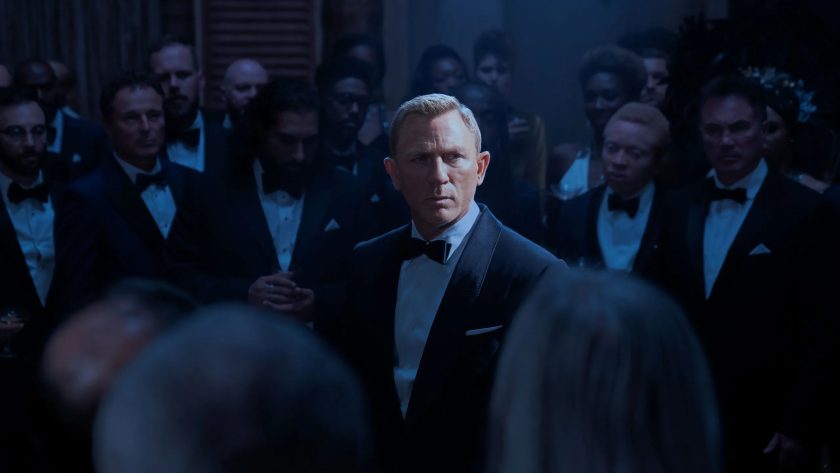Thomas Round analyses the legacy of the famed British spy James Bond in the context of his reputation, his origins, and the myths surrounding him.
Ever since his first incarnation in Ian Fleming’s Casino Royale in 1953, the name James Bond has been synonymous with suaveness, sophistication, sexuality, and, most importantly, Britishness. Emerging from the mind of a hungry and imaginative ‘man in the chair’, envious of those out in the field while he himself slaved behind a desk, Fleming created Bond as an ideal of masculinity so that, through him, he could vicariously live out his wildest fantasies. This genesis is key in unEver since his first incarnation in Ian Fleming’s Casino Royale in 1953, the name James Bond has been synonymous with suaveness, sophistication, sexuality, and, most importantly, Britishness. Emerging from the mind of a hungry and imaginative ‘man in the chair’, envious of those out in the field while he himself slaved behind a desk, Fleming created Bond as an ideal of masculinity so that, through him, he could vicariously live out his wildest fantasies. This genesis is key in understanding Bond and the nature of his character – he is more than a man of flesh and blood – he is a man of the imagination. Just as grounded in reality as an intoxicated fever-dream, though equally swaying as one.

Fleming continued his Bond saga over thirteen further novels up until his death in 1964; of course, Bond lived on, being reincarnated not only by other authors such as Kingsley Amis, John Pearson, and many more, but subsequently and most notably, in the world of cinema. Terence Young’s Dr. No, 1962, consecrated Bond as a figure of British iconicity and committed Sean Connery to the Hall of Fame in Stardom. Though, as we have seen, Bond transcends flesh and blood, even outliving his own creator. Thus, as Connery aged, Bond possessed a range of new bodies: George Lazenby, Roger Moore, Timothy Dalton, Pierce Brosnan, and, as of most recent, Daniel Craig. His cinematic lifespan has covered more than fifty years, while his literary one, has almost seventy.
We see then, as the name James Bond takes on new faces, is adopted by new storytellers, survives the ages, he becomes diluted from a singular character – he becomes more of an idea, of a myth or legend much like the great figures of old mythology – Odysseus, Aeneas, Thor or Beowulf. Anyone could take a character of Arthurian Legend and spin them a yarn, and anyone today – when provided the rights – can do the same for Bond. In the death of Fleming, there is no singular force presiding over his name, and thus the responsibility of Bond’s legacy rests in our own hands.
That being said, there are some central features that are key in characterising James Bond. Let us first establish what he is not: James Bond is not persuaded by the passage of time. As previously stated, his career has covered almost seventy years, though his life spans over a century. He has fought in the Second World War, taken part in Cold War operations, and driven a 2015 Aston Martin DB10 – he simply does not age. And if his apparent baptism in the Fountain of Youth were not enough, what’s more, is he is completely unvanquishable; over 26 cinematic appearances, Bond has escaped, outran, outsmarted the most impossible traps, henchmen, foes known to the imagination, no matter how impossible the scenario. This is the same man who has ridden a motorcycle and shot a pilot as his plane was taking off, boarded it and abandoned said motorcycle, and then commandeering it mid-air; this is the same man who has been shot atop a train, fallen a hundred feet into water, and flown through rapids while avoiding drowning; this is the same man who has jumped from a plane without a parachute, overpowered a henchman mid-air, stolen his parachute and floated away to safety. James Bond simply cannot be killed.

As an audience member, this forces one to see him in a different light. He becomes more than just a man – men are subject to the passing of time; Bond is not. A man could not survive such feats; Bond could – and then again 25 more times. Therefore, to the spectator he becomes more of a legend, in the same vein as those in Ancient Greece would have perceived Hercules – like a demi-god.
So, what can we say Bond is? He must be immortal. Indeed, this may seem ridiculous – how can one possibly enjoy a film about an immortal protagonist? Where are the stakes? What is the conflict? To that, one must recognise the importance of suspension of disbelief. To ask such questions is to also ask why we indulge the actor onstage, pointing at them and shouting “stop pretending!”. When consuming a piece of Bond content, whether it be a book or a film, we undergo a silent contract that says: ‘I understand that none of this is real, it’s all fiction, that Bond is the goodie and the other one is the baddie, and that he will get the girl, and rule Britannia, and God save the Queen’.
When one sits down to enjoy a Bond film or (now more rarely) book, one suspends their disbelief, and the auteur seeks to shock and surprise within those key tropes that make Bond Bond. The nuance lies in making one entertained inside those bounds established throughout the canon – it’s the rules of the game. Anything else within that is up to the storyteller, but if that storyteller is not Ian Fleming, no breaking any rules – no cheating. When we try to cheat these rules, the game loses its power; anyone who has tried to play a game with a five-year-old knows just quite how drab this can be – their rule book seems to undergo redrafts as they begin to lose. One of these rules for Bond, as we have seen, is that he always makes it out alive. Of course, it is easy to shock by breaking this rule, but, while not only lazy, it reverses the very thing that made him a legend in the first place – he cannot be killed. With rules, there are stakes, and with stakes, there is a plot. And while these rules had been long established over the past half-century, Barbara Broccoli seemed it justified to transgress them nonetheless in 2021, sixty-eight years after Casino Royale was released.
The glaring fault in this argument of James Bond’s divinity lies in the release of No Time To Die, directed by Cary Joji Fukunaga. In this film, the audience witnesses the impossible – no, not an untimely escape or an improbable win, but the death of James Herbert Bond, 19201-2021, taken so young in the line of action at the measly age of 101.

Examining this on paper, the absurdity of a man over a century old, still gun-toting, finally shuffling off his mortal coil is glaring. How can a character who is impervious to age and danger possibly be killed? To accept such a notion is to contaminate the carefully controlled environment that is the fictional realm of Bond. Its dependent variables are simple: he must be British, he must be charming, he must be handsome, he must be deadly, he must not age, and he must not die – yet this compromises that, and thus the narrative’s integrity as a whole. To kill Bond is to conflate the worlds of truth and fiction, to bring real stakes to an unreal world. What was once an ageless figure of legend is now a 101-year-old miracle of science – we’ve gone from Action to Science-Fiction in one single character death.
Though No Time To Die is not the most tragic casualty of the death of Bond, but rather the canon as a whole. Posing the stakes of mortality to an immortal Bond halts this suspension of disbelief which the people have adopted ever since 1953. No longer can we look back on him as a man impervious to threat – he is now a mortal. So how can a mortal have lived for so long, lived through so many generations, survived such unrealistic scenarios, and yet still be mortal? It goes from legend to farce, and therefore to accept Bond’s death is to nullify the rest of the series. This mistake of a film, if welcomed by the people, threatens to compromise every other film or book that has come before it; to welcome No Time To Die into the canon is to poison Bond’s entire legacy.
It is for this reason that No Time To Die is an incongruence in the James Bond canon, and therefore cannot count as such. What is indeed canon can itself be an elusive debate in the absence of an absolute author – it seems that, like many things, the canon is dictated by money. The rights to Bond were acquired by Albert R. Broccoli following Fleming’s death, and subsequently, his daughter, Barbara, who has kept a vice hold onto him; as such, the Broccoli estate possesses almost total control over the canon. A large degree of control, however, also falls into the hands of Daniel Craig. He is the face of Bond, and by the public putting its faith in him, he is given power. If he doesn’t want to act it, Bond doesn’t do it – it’s as simple as that. In the absence of a canon-abiding Fleming, these two juggernauts are free to ram 007 into the ground, and Craig can indulge his fantasy: ‘if I can’t be Bond, no one can’.
Many are soothed by the notion that it is more likely than not for Broccoli to resurrect Bond in a new incarnation – Henry Cavil, Idris Elba or Tom Hardy seem the most popular choices as of late. Yet this is not a solution to the canonical problem which has been established – in fact, it poses a whole new one. Craig’s Bond, despite only one of them being based on a Fleming book, tied together every other cinematic Bond since Sean Connery. Blofled, for example, was incarnated in Spectre (2015) and No Time To Die (2021) by Christoph Waltz, though is first mentioned in Thunderball (1965), and was most famously portrayed by Donald Pleasance in You Only Live Twice (1967). At the end of Spectre, Craig is taunted by Blofeld, who references his past even during the other actors’ incarnations. This ties together Craig and Connery’s Bond as the same character. From this, we can assume that, despite each actor bringing a new face to the role, they are each playing the same canonical version. Therefore, if he is indeed now dead, there is no bringing him back. Not unless they create a whole new version of him and start again – but then again, what’s the point? What purpose does that serve? Does the audience now adopt two cinematic Bond canons? Why should anyone care about a character who is supposedly mortal yet who can also be resurrected? What’s fun about pretending that the last films didn’t happen, and starting all over again? The rightsholders have gotten a little too greedy, and now the fans must pay the price.

This comes back to the wider debate of what can be considered canon, of the public domain versus private estates looking to preside over their beloved characters. Whereas once these characters rested solely in the hands of the people – the Gawain Poet never had to option the rights for Sir Gawain and the Green Knight – now they rest in the hands of corporations, corporations which outlive original authors. So how can we nurture characters that outlive their creators? Is it even possible in an age where content is so in demand and money is so often prioritised above artistic integrity?
It is a little radical – not to mention unrealistic – to suggest that we should let these characters die with their authors. If the people love them and there is a market, they will be given a platform. Equally, pernicious as it may be, it is unrealistic to propose a solution to these conglomerates hoarding the rights to such characters. In an ideal world, the rights would belong to the public, but things don’t work like that on planet Earth. Instead, a realistic solution is that those in charge of famed and beloved characters who were not originally their own must make it their duty not only to seek monetary gain from them, but to see that they are treated as the author may have and that they abide by the same laws that first made them compelling. Otherwise, we run the risk of degrading such characters until their only function is to remind us of what they once were until they fade out into a waning market faster than you can say ‘shaken, not stirred’.
For Bond, this means preserving the rules of his character established by the original author – indeed, making him a staple of suaveness, sophistication, sexuality, Britishness, and too, in order for us to continue to suspend our disbelief throughout the preceding canon, he must survive. If those rules seem unfavourable – fine, go write another character. There’s nothing wrong with saying ‘James Bond doesn’t work anymore’, but there is no logicality to trying to bend James Bond into something that he is not – a laws-of-physics-abiding mortal; no matter how much money you pay, no matter what your piece of paper says, you do not have the right.
Myths and legends belong to the people – James Bond is no exception. The first step to reclaiming him is to reject No Time To Die and to recognise it for what it is: a canonical incongruence.
1 Cited from The Authorized Biography of 007 by John Pearson, written in 1973.




